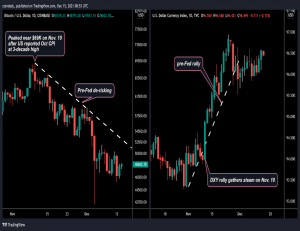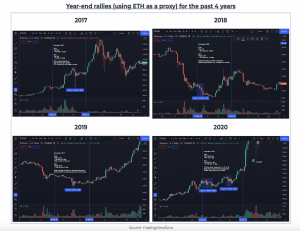A major risk reduction event has already taken place, leaving the door open for a classic “real buy” transaction following the Fed’s decision.

Bitcoin seems to have swallowed the recent devaluation of the US Central Bank’s anti-inflation policy with a significant decline in recent weeks. Analysts say the cryptocurrency could see a bearish rally after the Fed’s decision on Wednesday.
Paulist expectations have risen following rising inflationary pressures and President Jerome Powell’s recent decision not to use the word “temporary” in discussions about inflation. Restrictive monetary policy is generally considered bearish (hedging inflation risk and emerging technologies) for assets, including Bitcoin. That said, there has already been a significant elimination of risk, leaving the door open for the classic “de facto purchase” or recovery of the relief caused by the long-awaited negative announcement.
As seen in the feature image, the bitcoin reached close to 69 69,000 on November 10, when the US Consumer Price Index (CPI) touched a three-decade high of 6.2% in October, but since then It has dropped by more than 30% since then. In November, the CPI reached a four-decade high of 6.8%. The dollar index, which tracks the value of the greenback against major currencies such as the euro, pound and yen, has risen more than 2% over the past few weeks, reaching a 16-month high of 96.93.
The two-year Treasury yield, which mimics short-term inflation and interest rate expectations, recently hit an 18-month high of 0.72%. Meanwhile, the Fed Funds Futures extended the period for the first interest rate hike to May 2022 and set a price target of at least three hikes for next year. Like this, The likelihood of a massive sell-off for the Fed’s announcement is relatively low unless the central bank signals more severe austerity than has been taken. Said Krueger, stock strategist at LMAX Digital. “It changes the balance of risk.”

Focus on peak rates:
With expectations of faster cuts and three interest rate hikes, the focus will be on the central bank’s high interest rate forecast. The consensus is that the forthcoming tight rate hike cycle will push interest rates higher than the 2.5% seen in the previous cycle from December 2015 to December 2018.
I. Introduction
– Briefly explain the recent decline in Bitcoin’s value
– Mention the Federal Reserve’s hawkish policy shift and its potential impact on the cryptocurrency market
II. Background: Federal Reserve’s Policy Shift
– Explain the Federal Reserve’s recent decision to raise interest rates and its implications for the economy
– Discuss how this shift in monetary policy could affect the cryptocurrency market
III. Bitcoin’s Decline: A Sign of Priced-In Hawkish Policy?
– Analyze the recent decline in Bitcoin’s value and its potential connection to the Federal Reserve’s policy shift
– Examine historical data and market trends to support the argument
IV. Market Sentiment and Investor Behavior
– Discuss how investor sentiment and behavior may be influencing the cryptocurrency market
– Explore how the fear of rising interest rates and a potential economic downturn could be driving Bitcoin’s decline
V. Implications and Future Outlook
– Discuss the potential implications of the Federal Reserve’s policy shift on the cryptocurrency market
– Examine possible future scenarios for Bitcoin and the broader cryptocurrency market
VI. Conclusion
– Summarize the main points and reiterate the potential connection between Bitcoin’s decline and the Federal Reserve’s hawkish policy shift.
Bitcoin’s Decline Suggests Fed’s Hawkish Policy
The recent decline in Bitcoin’s value has left many investors wondering if the cryptocurrency market is headed for a prolonged downturn. While there are many factors that could be contributing to Bitcoin’s decline, one possible explanation is that the market has already priced in the Federal Reserve’s hawkish policy shift.
In this article, we’ll explore the possible connection between Bitcoin’s decline and the Federal Reserve’s decision to raise interest rates. We’ll also examine historical data and market trends to support our argument.
Background: Federal Reserve’s Policy Shift
The Federal Reserve recently raised interest rates for the first time in nearly a decade, signaling a shift towards a more hawkish monetary policy. This move was widely anticipated by investors, who have been pricing in the expected rate hike for months. However, the impact of this policy shift on the cryptocurrency market has been less clear.
Bitcoin’s Decline: A Sign of Priced-In Hawkish Policy?
Bitcoin’s value has been declining steadily over the past few weeks, leading some investors to wonder if the cryptocurrency market is headed for a prolonged downturn. While there are many factors that could be contributing to Bitcoin’s decline, one possible explanation is that the market has already priced in the Federal Reserve’s hawkish policy shift.
Historical data suggests that Bitcoin’s value tends to decline when interest rates rise. This is because higher interest rates make traditional assets like bonds and stocks more attractive to investors, reducing the appeal of riskier assets like cryptocurrencies.
Market Sentiment and Investor Behavior
Investor sentiment and behavior may also be playing a role in Bitcoin’s decline. As the fear of rising interest rates and a potential economic downturn grows, investors may be becoming more risk-averse, leading them to sell their holdings in risky assets like cryptocurrencies.
Implications and Future Outlook
If the Federal Reserve’s hawkish policy shift is indeed priced into the cryptocurrency market, we could see a prolonged downturn in Bitcoin’s value. However, it’s important to note that the cryptocurrency market is highly volatile, and prices can fluctuate rapidly.
In the short term, we could see Bitcoin’s value continue to decline as investors become more risk-averse. However, in the long term, the fundamentals of the cryptocurrency market remain strong, and we could see a resurgence in Bitcoin’s value once the market has fully priced in the Federal Reserve’s policy shift.
Bitcoin’s decline suggests that the Federal Reserve’s hawkish policy shift may be priced into the cryptocurrency market. While there are many factors that could be contributing to Bitcoin’s decline, the historical data and market trends suggest that the recent rate hike may be a significant contributor. As the cryptocurrency market continues to evolve, it’s important to keep a close eye on interest rates and investor sentiment, as these factors could have a significant impact on Bitcoin’s value in the future.


